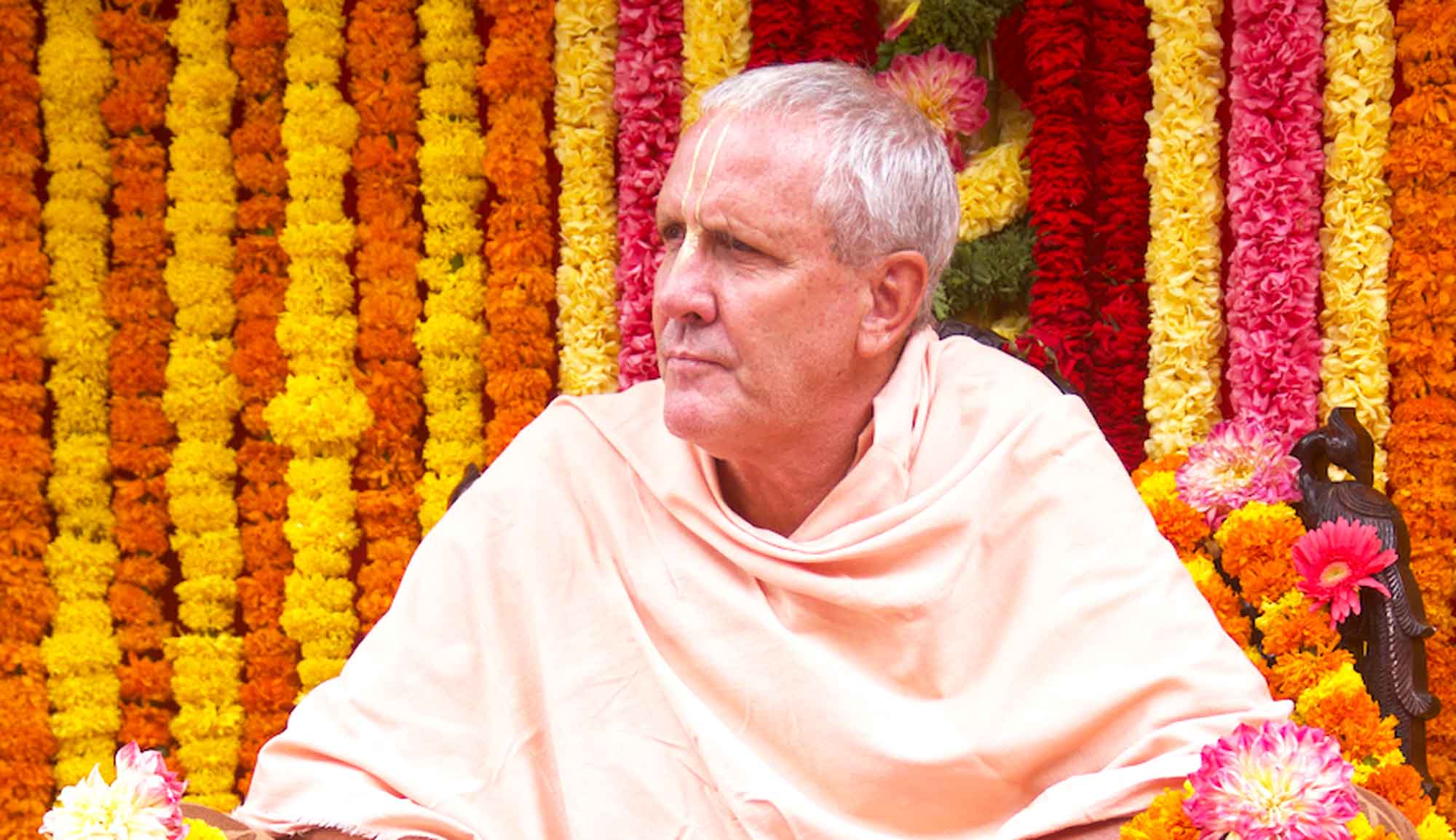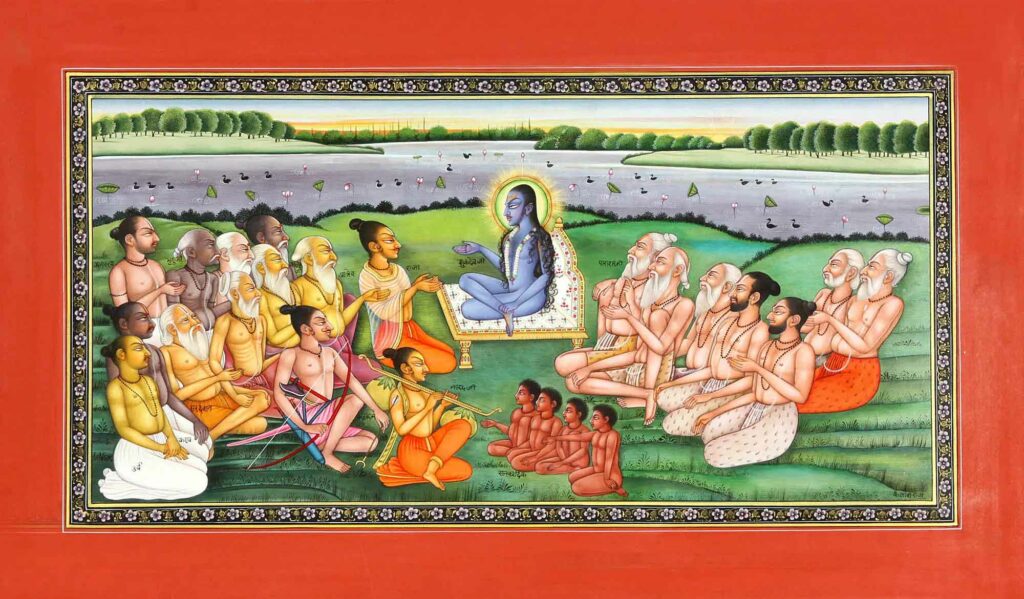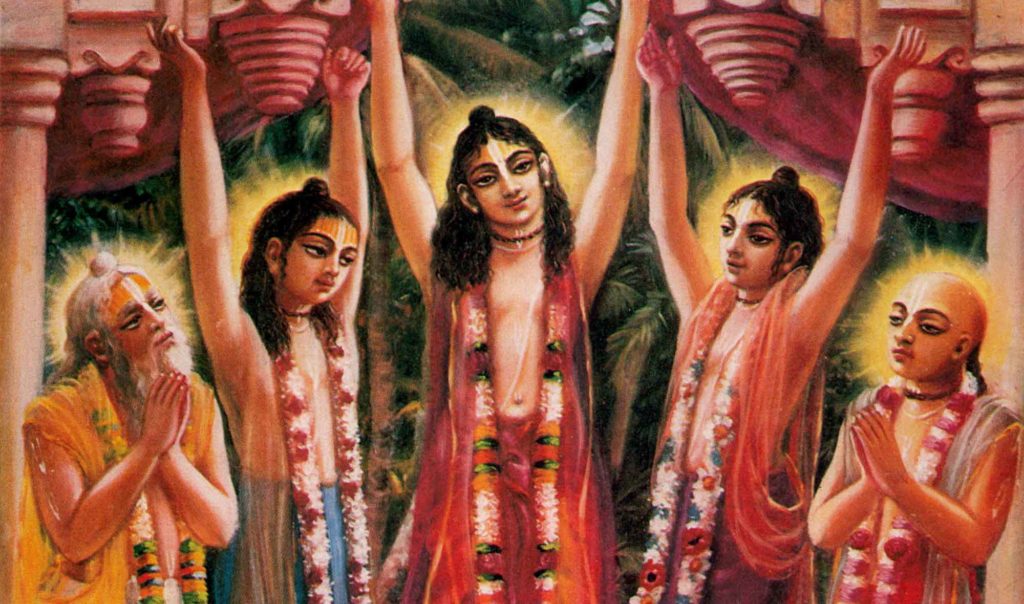Overview
‘We Are Śuddha Śaktas’ is an article by Swami B.G. Narasingha, published on August 20th 2001, adapted from a class he gave in Boston on December 12th 2001. Swami Narasingha explains the various gurus of Raghunātha Dāsa Gosvāmī, his position as the prayojana-ācārya, and how Gauḍīyas are śuddha Śaktas – worshippers of the Energy of Godhead.
Once we counted Raghunātha Dāsa Gosvāmī’s gurus, and we found that he had nine gurus. So then the question is, “Which one of his gurus is most important?” He had nine gurus: Yadunandana Ācārya was the mantra guru who gave him initiation, dīkṣā. Then on the way to meet Mahāprabhu, he received the blessing of Nityānanda Prabhu, by putting on that yogurt and rice festival; you may have heard about this. Who is Nityānanda? He is Baladeva, he is the original guru-tattva, so is it possible that he served Nityānanda Prabhu and abided by His orders, but he did not find any guru there? Did he only see a Vaiṣṇava there, only a devotee?
No, there is guru-tattva; Nityānanda is also his guru. Then Nityānanda Prabhu sent him to Purī, and Mahāprabhu turned him over to Svarūpa Dāmodara, and said, “You will give him training.” Svarūpa Dāmodara became his teacher. Living in Purī at that time was Nāmācārya Haridāsa Ṭhākura. He is the ācārya of chanting of the Holy Name; could he just pass him by, saying, “Oh, no he is not my guru?” No, he had to accept him, “He is also my guru, Nāmācārya Haridāsa Ṭhākura.”
Śrī Rūpa and Sanātana were also living there, the sambandha-ācārya and the abhidheya-ācārya – the foremost of the Six Gosvāmīs. First, Raghunātha Dāsa Gosvāmī lived in Purī under the care of Mahāprabhu and Svarūpa Dāmodara, and he later lived under the care of Rūpa and Sanātana for a long time. Also living there at that time was Gadādhara Paṇḍita. Gadādhara Paṇḍita is guru-tattva for the mādhurya-rasa bhaktas in caitanya–līlā, and Mahāprabhu is the principal Deity. The mādhurya devotees are under Gadādhara Paṇḍita, and the vātsalya and other devotees are under Nityānanda Prabhu. So he is also accepting Gadādhara Paṇḍita as guru. Gadādhara Paṇḍita is rādhā-bhāva; he is an incarnation of Śrīmatī Rādhārāṇī. So can he not accept that as guru? So he also accepted Gadādhara Paṇḍita as guru.
After the disappearance of Mahāprabhu, all these great personalities began to vanish from the earth very quickly, and Raghunātha Dāsa was in great despair. He decided to commit suicide; the world became so bleak in the absence of Mahāprabhu and all the devotees leaving one after another that he decided to take the path of suicide. Narottama Dāsa expresses this same sentiment when he prays, “What will we do now? They are all gone!” and beats his head on a stone. It is not a happy day when the Lord’s devotees vanish from this world, from our sight. So he was very distressed and he decided to give up his life, and he thought that the best way is if he can jump from the top of Govardhana Hill, and in this way he will finish his life. Actually, this is love despair.
If you have seen Govardhana Hill, you may understand that one would have to jump about one hundred times. You would do better jumping off a garage roof; it is not very high – better to climb a temple, or a tree even. Govardhana Hill is very gentle; there is no place from which to jump. Because that was his heart’s sentiment, he went to Govardhana with this in mind, but there he found Rūpa and Sanātana. They were living there on the order of Mahāprabhu, and he found that Mahāprabhu was living with Rūpa and Sanātana. This is what he found there: that his Supreme Lord is living within their hearts. For him, Rūpa and Sanātana are like expansions of Mahāprabhu, non-different from Mahāprabhu. They are Rūpa and Sanātana, and yet he finds them to be non-different. So then he gave up this idea of jumping from Govardhana Hill and he remained under their shelter for many years.
Raghunātha Dāsa Gosvāmī has shown us by the example of his life that we may have many, many gurus who first may bring us in some connection with Kṛṣṇa Consciousness. Maybe it is our parents; maybe it is a friend at school, or some general connection draws us towards the first Sunday feast. Whatever it is – it may be something at home, such as Back to Godhead magazine. What first put us in connection to Kṛṣṇa is called vartmana-pradarśaka-guru, and we may have many of this type, but it is said that you should only have one mantra-guru. You should have only one initiating guru, but śikṣā–gurus you may have many.
Raghunātha Dāsa Gosvāmī had many gurus who gave him much instruction and guided him through his life. He himself is known as the prayojana-ācārya: he shows us the highest perfection of devotion in the line of Śrī Caitanya Mahāprabhu. Raghunātha Dāsa Gosvāmī announces to the world what is the highest aspiration and achievement for a Gauḍīya Vaiṣṇava, a follower of Śrī Caitanya Mahāprabhu; he shows what is that highest achievement. He announces this in his prayers and in his poems, in his poetic expressions. At the very end of his life he announces this; therefore, he is known as the prayojana-ācārya.
What is the perfection? What is that highest perfection of any Gauḍīya Vaiṣṇava? It is the thing that Śrīla Prabhupāda saw in his father when he was a boy, but did not recognize in him until he had become a disciple of Śrīla Bhaktisiddhānta. There was something in Śrīla Prabhupāda’s father that later – as a disciple of Śrīla Bhaktisiddhānta, as a Gauḍīya Vaiṣṇava – Śrīla Prabhupāda could understand, “My father was pure devotee of Kṛṣṇa.” When he was growing up he had no such understanding. His father was just his father; he used to get him to buy not just one toy gun, but two toy guns. But as an adult, as a disciple of Śrīla Bhaktisiddhānta, then he came to note one very special thing in his father, so much so that he boldly wrote in the Kṛṣṇa Book dedication, “To my father, Gaura Mohana De, a pure devotee of Kṛṣṇa.”
But if you study Gaura Mohana De’s life, you will see that there are three million such pure devotees of Kṛṣṇa. They worship Kṛṣṇa at home, they go to the shop and they come back, they visit temples and they give some gifts to sādhus, and other such things. So what is it that distinguishes his father from so many Hindu gentlemen raising their families in pious India, close to one hundred years ago? It is that very thing which is announced by Raghunātha Dāsa Gosvāmī. He announced that our highest aspiration is to be accepted into the line of service to Śrīmatī Rādhārāṇī. That is called rādhā-dāsyam: service of Śrīmatī Rādhārāṇī. Rādhā-dāsyam supersedes even service to Kṛṣṇa. Śrīla Prabhupāda’s father was doing this all along, when Prabhupāda was a boy.
You will read in Satsvarūpa Mahārāja’s book that Prabhupāda is telling, “My father used to gather many sādhus and he would take care of them, and even he would give them a hookah.” A hookah is a pipe. That social custom was the order of the day; now it is low-fat yogurt. But in those days there were so many sādhus of different types, and there were the sādhus who had the hookahs, and so they were offered the hookah. If someone here were to offer me a hookah, any devotees attending the lecture would get up and walk out, saying, “He is bogus.” But Śrīla Prabhupāda’s father had a hookah and offered it to the sādhus. That was the basic idea; whatever the sādhus want, they get it, and they will be happy. Then of course he would give them laḍḍus, purīs, subjīs, and very nice refreshments, and then he would ask some benediction. And what would he ask, what would Prabhupāda’s father ask those sādhus?
Prabhupāda’s father would ask, “Please bless my son that he will become a devotee of Śrīmatī Rādhārāṇī and spread her glories all over the world.” So as a youth this made some sense to him, but not as much sense as it would make later. When Śrīla Prabhupāda met his eternal master, Śrīla Bhaktisiddhānta Sarasvati Ṭhākura, then everything came into clear focus. He then knew what was to be his purpose in this world, what he was to do.
This is all going on in the plane of līlā of the eternally liberated souls. Some people think that when they are born, the eternally liberated souls are thinking, “I’m just waiting to start my movement,” while rocking in their mothers’ arms. No, they are acting as children at that point.
Śrīla Prabhupāda used to laugh and talk about his ‘māyā;’ he used to call it his ‘māyā:’ He was a follower of Gandhi, and when he said that we would say, “Oh Prabhupāda! No māyā for you!” But he would laugh. Even when a liberated soul comes into this world he does not manifest, in most cases, why he has come here until he makes the connection with the line of Mahāprabhu, the descending line of the Supreme Lord. Then, making that connection, things come down to him and are revealed, such as what is his purpose here, what is his mission here. So that is the announcement of Raghunātha Dāsa Gosvāmī; he has announced that in his writings, in his prayers: his deep heartfelt aspiration for the service of Śrīmatī Rādhārāṇī.
You all know Rādhā-kuṇḍa, and you know many people come to Rādhā-kuṇḍa, and they do there what is called daṇḍavat-parikramā. They offer full daṇḍavats, they put one stone, walk to the place of the stone, again go down, offering prayers, and in this way they go all the way around Rādhā-kuṇḍa. It takes a couple of hours. Many years ago, the Diwan of Bharatpur came, and with his royal family was doing daṇḍavat-parikramā of Rādhā-kuṇḍa. One personal servant of Śrīla Bhaktisiddhānta who happened to be there at that time came running and said, “Oh Guru Mahārāja, the Diwan of Bharatpur has come with his whole family and they are doing parikramā of Rādhā-kuṇḍa! It is wonderful that they have such devotion for Śrīmatī Rādhārāṇī.” Then Śrīla Bhaktisiddhānta shocked everyone there. He said, “Actually, their devotion is just the opposite of ours. They have heard that Rādhārāṇī is dear to Kṛṣṇa, and so they have some regard for Her. Ours is just the opposite: the only reason we have any interest in Kṛṣṇa is because He is dear to Śrīmatī Rādhārāṇī – we are on this side, not on that side.”
When you have gone through the whole thing you realise that we are śuddha Śaktas; we are worshippers of the Energy of Godhead, the Devotional Energy of Godhead. If you do not believe it, then just start reading Śrīla Prabhupāda’s books carefully and you will understand the importance of this conclusion. The whole of the Śrīmad Bhāgavatam is to present one thing, and only one thing – that Śrīmatī Rādhārāṇī is the foremost servant of Kṛṣṇa.
Rādhārāṇī alone is the one who can please Kṛṣṇa: She is the mother of devotional energy. And as a jīva soul, the highest attainment is to be accepted as a servant in the descending line of Her grace.
Related Articles
- Śrī Śrī Rādhā Kṛṣṇa & The Fountainhead of All Tattvas by Śrīla Bhakti Pramoda Purī Gosvāmī
- A Prayer Composed on the Occasion of the Disappearance of Śrīla Gadādhara Paṇḍita by Śrīla Bhakti Pramoda Purī Gosvāmī
- The Appearance of Śrīla Gadādhara Paṇḍita by Śrīla Bhakti Rakṣaka Śrīdhara Deva Gosvāmī
- Śrī Śarādīyā Pūjā by Śrīla Bhakti Rakṣaka Śrīdhara Deva Gosvāmī
- Śrī Lalitā Devī and Śrīmatī Rādhārāṇī by Śrīla Bhakti Rakṣaka Śrīdhara Deva Gosvāmī
- The Appearance of Rādhā-kuṇḍa by Śrīla Bhakti Rakṣaka Śrīdhara Deva Gosvāmī
- From Śraddhā to Prema by Śrīla Bhakti Gaurava Narasiṅgha Mahārāja
- Gāyatrī as Rādhārāṇī by Śrīla Bhakti Gaurava Narasiṅgha Mahārāja
- My Guru is Rādhārāṇī by Śrīla Bhakti Gaurava Narasiṅgha Mahārāja
- The Greatest Negative by Śrīla Bhakti Gaurava Narasiṅgha Mahārāja
- Śrī Rādhāṣṭamī by Śrīla Bhakti Gaurava Narasiṅgha Mahārāja
- Śrīla Śrīdhara Mahārāja and the Gem of All Conceptions by Śrīla Bhakti Gaurava Narasiṅgha Mahārāja
- Planets of Faith by Śrīla Bhakti Gaurava Narasiṅgha Mahārāja
- Rādhā-Pāda Darśana by Śrīla Bhakti Gaurava Narasiṅgha Mahārāja
- The Definition of Faith by Gaura Gopāla Dāsa
Further Reading
Prema Dhāma Deva Stotram with the Narasiṅgha Sevaka Commentary – Verses 61-65
In verses 61 to 65 of 'Prema Dhāma Deva Stotram', Śrīla Śrīdhara Mahārāja narrates the pastime of Śrī Caitanya at Caṭaka Parvata In Purī and explains how the scriptures produced by Brahmā and Śiva are ultimately searching for the personality of Mahāprabhu who is merciful too all jīvas, no matter what their social position.
Prabhupāda Śrīla Sarasvatī Ṭhākura’s Visit to Ayodhyā
With the forthcoming observance of Śrī Rāma Navamī, we present 'Prabhupāda Śrīla Sarasvatī Ṭhākura’s Visit to Ayodhyā' written by Śrīla Bhaktisiddhānta Sarasvatī Ṭhākura Prabhupāda from The Gaudīyā magazine, Vol 3. Issue 21/ In December 1924, after visiting Benares and Prāyāga, Sarasvatī Ṭhākura visited the birth-site of Śrī Rāmācandra in Ayodhyā.
Śaraṇāgati – The Only Path to Auspiciousness
In this article, 'Śaraṇāgati - The Only Path to Auspiciousness', Dhīra Lalitā Dāsī analyses the process of śaraṇāgati (surrender) beginning with śraddhā (faith). She also discusses the role of śāstra and the Vaiṣṇava in connection with surrender.
Ātma Samīkṣā – The Value of Introspection
In this article, "Ātma Samīkṣā – The Value of Introspection" Kalki Dāsa highlights the importance of introspection in the life of a devotee and especially in relation to the worldly environment that surrounds us. He also explains how transcendental sound influences our capacity to introspect.
Prema Dhāma Deva Stotram with the Narasiṅgha Sevaka Commentary – Verses 61-65
In verses 61 to 65 of 'Prema Dhāma Deva Stotram', Śrīla Śrīdhara Mahārāja narrates the pastime of Śrī Caitanya at Caṭaka Parvata In Purī and explains how the scriptures produced by Brahmā and Śiva are ultimately searching for the personality of Mahāprabhu who is merciful too all jīvas, no matter what their social position.
Prabhupāda Śrīla Sarasvatī Ṭhākura’s Visit to Ayodhyā
With the forthcoming observance of Śrī Rāma Navamī, we present 'Prabhupāda Śrīla Sarasvatī Ṭhākura’s Visit to Ayodhyā' written by Śrīla Bhaktisiddhānta Sarasvatī Ṭhākura Prabhupāda from The Gaudīyā magazine, Vol 3. Issue 21/ In December 1924, after visiting Benares and Prāyāga, Sarasvatī Ṭhākura visited the birth-site of Śrī Rāmācandra in Ayodhyā.
Śaraṇāgati – The Only Path to Auspiciousness
In this article, 'Śaraṇāgati - The Only Path to Auspiciousness', Dhīra Lalitā Dāsī analyses the process of śaraṇāgati (surrender) beginning with śraddhā (faith). She also discusses the role of śāstra and the Vaiṣṇava in connection with surrender.
Ātma Samīkṣā – The Value of Introspection
In this article, "Ātma Samīkṣā – The Value of Introspection" Kalki Dāsa highlights the importance of introspection in the life of a devotee and especially in relation to the worldly environment that surrounds us. He also explains how transcendental sound influences our capacity to introspect.








